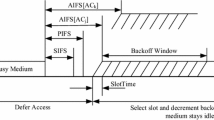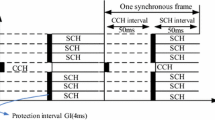Abstract
This paper proposed an MAC (Media Access Control) operation method based on the CCH (Control Channel) and SCH (Service Channel) control mode of the WAVE (Wireless Access for Vehicle Environment) network in order to secure service performance sensitive to certain delays with no restriction to services pursued in the present WAVE network. The proposed method configures a new superframe for CCH and SCH frames in the WAVE network defined by IEEE Std. 1609.4 and applies TDM (Time Division Multiplexing) to the CCH frame in order to secure traffic stability and latency minimization in each terminal. CSMA/CA (Carrier Sense Multiple Access/Collision Avoidance) is applied to the SCH frame in order to secure autonomy in service perspectives. Additionally, delay control is secured despite congestion among multiple terminals in V2V communication without a station RSU (Road Side Unit) since the proposed MAC operation method adopts a new CCH/SCH coordination mode for the WAVE network. The proposed method’s applicability is verified as the simulation analysis results showed satisfactory low latency performance.


















Similar content being viewed by others
References
3GPP Technocal Report, 22.885, Study on LTE support for V2X Services, v14.0.0, Dec. 2015
Bianchi G (2000) Performance analysis of the IEEE 802.11 distributed coordination function. IEEE J Sel Areas Commun 18(3):535–547
Bilstrup K, Uhlemann E, Strom EG, Bilstrup U (2008) Evaluation of the IEEE 802.11p MAC Method for Vehicle-to-Vehicle Communication. In: Proceedings of the 2008 IEEE 68th Vehicular Technology Conference, Calgary, BC, Canada, pp. 1–5, 21–24 September 2008
Delice MD, Ghandour AJ, Artail H, Bononi L (2012) Enhancing the performance of safety applications in IEEE 802.11p/WAVE Vehicular Networks. In: Proceedings of the 2012 IEEE International Symposium on a World ofWireless, Mobile and Multimedia Networks (WoWMoM), San Francisco, CA, USA, pp. 1–9, 25–28 June 2012
Hobert L, Festag A, Llaster I, Altomare L, Visintainer F, Kovacs A (2015) Enhancements of V2X communication in support of cooperative autonomous driving. IEEE Commun Mag 53(12):64–70
Hwang TW (2013) Trend of V2X vehicle communication technology development based on IT convergence. Journal of Communications & Radio Spectrum 54:4–19
IEEE (2010) Draft Standard for Wireless Access in Vehicular Environments (WAVE)—Remote Management Services. IEEE P1609.1/D1.3
IEEE (2010) IEEE Standard for Wireless Access in Vehicular Environments (WAVE)—Networking Services. IEEE Standard 1609.3–2010
IEEE (2012) Draft Standard for Wireless Access in Vehicular Environments (WAVE)—Security Services for Applications and Management Messages. IEEE P1609.2/D17
IEEE (2013) IEEE Standard for Wireless Access in Vehicular Environments (WAVE)—Architecture. IEEE Standard 1609.0–2013
IEEE (2016) IEEE Standard for Wireless Access in Vehicular Environments (WAVE) - Multi-Channel Operation. IEEE Standard 1609.4–2016
Luoto P, Bennis M, Pirinen P, Samarakoon S, Horneman K, Latva-aho M (2016) System Level Performance Evaluation of LTE-V2X Network. In: Proc. IEEE European Wireless Conference, Finland, vol. 22, p 1–5
Mir ZH, Filali F (2014) On the performance comparison between IEEE 802.11p and LTE-based vehicular networks. In: Proc. IEEE Vehicular Technology Conference, Canada, vol. 79, p 1–5
Stibor L, Zang Y, Reumerman H (2007) Evaluation of Communication Distance of Broadcast Messages in a Vehicular Ad-Hoc Network Using IEEE 802.11p. In: Proceedings of the 2007 IEEE Wireless Communications and Networking Conference, Kowloon, China, pp. 254–257, 11–15 March 2007
Togou MA, Khoukhi L, Hafid A (2017) IEEE 802.11p EDCA performance analysis for vehicle-to-vehicle infotainment applications. In: Proceedings of the 2017 IEEE International Conference on Communications (ICC), Paris, France, p 1–6, 21–25 May 2017
Vukadinovic V, Bakowski K, Marsch P, Garcia ID, Xu H, Sybis M, Sroka P, Wesolowski K, Lister D, Thibault I (2018) 3GPP C-V2X and IEEE 802.11p for vehicle-to-vehicle communications in highway platooning scenarios. Ad Hoc Netw 74:17–29
Wang Q, Leng S, Fu H, Zhang Y (2012) An IEEE 802.11p-based multichannel MAC scheme with channel coordination for vehicular ad hoc networks. IEEE Trans Intell Transp Syst 13:449–458
Zhang L et al (2014) A scalable CSMA and self-organizing TDMA MAC for IEEE 802.11 p/1609. X in VANETs. Wirel Pers Commun 74(4):1197–1212
Acknowledgements
This work was supported by Institute for Information & communications Technology Promotion (IITP) grant funded by the Korea government (MSIT) (No. 2017-0-00400, Development of 100Mbps grade V2X and LTE communication system for cooperative driving).
Author information
Authors and Affiliations
Corresponding author
Ethics declarations
Conflict of interest
The authors declare no conflict of interest.
Additional information
Publisher’s note
Springer Nature remains neutral with regard to jurisdictional claims in published maps and institutional affiliations.
Rights and permissions
About this article
Cite this article
Lee, Y.S., Kim, SH. A proposal of novel design on the WAVE MAC algorithm with low-latency for seamless video surveillance in V2X environment. Multimed Tools Appl 79, 16035–16049 (2020). https://doi.org/10.1007/s11042-019-7151-1
Received:
Revised:
Accepted:
Published:
Issue Date:
DOI: https://doi.org/10.1007/s11042-019-7151-1




